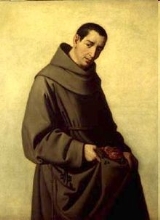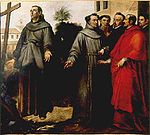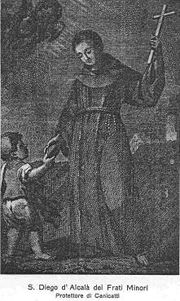
Didacus of Alcalá
Encyclopedia
Saint Didacus of Alcalá, (Latin: Sanctus Didacus Complutensis), Saint Diego, (or the more familiar ) was a lay brother
of the Order of Friars Minor who died at Alcalá de Henares
, Spain, November 12, 1463.
 His impoverished parents placed him as a child in the care of a hermit living not far from San Nicolás del Puerto
His impoverished parents placed him as a child in the care of a hermit living not far from San Nicolás del Puerto
Seville
- Spain
, his native town. Feeling called to the religious life, he applied for admission to the Franciscan Order at the convent of Arizafa and was received as a lay brother. In 1445 he was chosen guardian of the Franciscan community on the Canary Island
of Fuerteventura
, where in 1446, the Observantist Franciscans founded the Convent of San Buenaventura. There, though it was an exception to the ordinary rules for a lay brother to be made superior; his great zeal, prudence, and sanctity justified this choice.
In 1449 he was recalled to Spain, whence he went to Rome to be present at the canonization of Bernardino of Siena
in 1450. At Alatraz he fulfilled the humble office of infirmarian in the convent of Ara Coeli; and his biographers record the miraculous cure of many whom he attended, through his pious intercession. He was finally recalled to Spain and was sent by his superiors to the Convento de Santa María de Jesús in Alcalá, where he spent the remaining years of his life in penance, solitude, and the delights of contemplation. There he died on November 12, 1463 due to an abscess. It was said that it amazed everyone that instead of a foul odor, fragrance emitted from his infection. His body was also rumored to have remained incorrupt
, did not undergo rigor mortis
and continued to emit a pleasant odor.
 Saint Didacus was canonized by Pope Sixtus V
Saint Didacus was canonized by Pope Sixtus V
in 1588 and in the General Roman Calendar his feast day was celebrated on 13 November, since 12 November, the anniversary of his death, was occupied by that of Pope Saint Martin I
. However, the Franciscans celebrated his feast day on 12 November, and Saint Didacus's feast day was finally placed on 12 November for the whole of the Church in the 1969 revision of the General Roman Calendar, which also moved Pope Martin I's feast day to his dies natalis, 13 April.
Saint Didacus is the saint to whom the Franciscan mission
that developed into San Diego, California was dedicated.
The Spanish painter Bartolomé Estéban Murillo
is noted for painting representations of Didacus of Alcalá.
Lay brother
In the most common usage, lay brothers are those members of Catholic religious orders, particularly of monastic orders, occupied primarily with manual labour and with the secular affairs of a monastery or friary, in contrast to the choir monks of the same monastery who are devoted mainly to the...
of the Order of Friars Minor who died at Alcalá de Henares
Alcalá de Henares
Alcalá de Henares , meaning Citadel on the river Henares, is a Spanish city, whose historical centre is one of UNESCO's World Heritage Sites, and one of the first bishoprics founded in Spain...
, Spain, November 12, 1463.
History

San Nicolás del Puerto
San Nicolás del Puerto is a municipality in the province of Seville, Spain....
Seville
Seville
Seville is the artistic, historic, cultural, and financial capital of southern Spain. It is the capital of the autonomous community of Andalusia and of the province of Seville. It is situated on the plain of the River Guadalquivir, with an average elevation of above sea level...
- Spain
Spain
Spain , officially the Kingdom of Spain languages]] under the European Charter for Regional or Minority Languages. In each of these, Spain's official name is as follows:;;;;;;), is a country and member state of the European Union located in southwestern Europe on the Iberian Peninsula...
, his native town. Feeling called to the religious life, he applied for admission to the Franciscan Order at the convent of Arizafa and was received as a lay brother. In 1445 he was chosen guardian of the Franciscan community on the Canary Island
Canary Islands
The Canary Islands , also known as the Canaries , is a Spanish archipelago located just off the northwest coast of mainland Africa, 100 km west of the border between Morocco and the Western Sahara. The Canaries are a Spanish autonomous community and an outermost region of the European Union...
of Fuerteventura
Fuerteventura
Fuerteventura , a Spanish island, is one of the Canary Islands, in the Atlantic Ocean off the coast of Africa. It is situated at 28°20' north, 14°00' west. At 1,660 km² it is the second largest of the Canary Islands, after Tenerife...
, where in 1446, the Observantist Franciscans founded the Convent of San Buenaventura. There, though it was an exception to the ordinary rules for a lay brother to be made superior; his great zeal, prudence, and sanctity justified this choice.
In 1449 he was recalled to Spain, whence he went to Rome to be present at the canonization of Bernardino of Siena
Bernardino of Siena
Saint Bernardino of Siena, O.F.M., was an Italian priest, Franciscan missionary, and is a Catholic saint.-Early life:...
in 1450. At Alatraz he fulfilled the humble office of infirmarian in the convent of Ara Coeli; and his biographers record the miraculous cure of many whom he attended, through his pious intercession. He was finally recalled to Spain and was sent by his superiors to the Convento de Santa María de Jesús in Alcalá, where he spent the remaining years of his life in penance, solitude, and the delights of contemplation. There he died on November 12, 1463 due to an abscess. It was said that it amazed everyone that instead of a foul odor, fragrance emitted from his infection. His body was also rumored to have remained incorrupt
Incorruptibility
Incorruptibility is a Roman Catholic and Eastern Orthodox belief that supernatural intervention allows some human bodies to avoid the normal process of decomposition after death as a sign of their holiness...
, did not undergo rigor mortis
Rigor mortis
Rigor mortis is one of the recognizable signs of death that is caused by a chemical change in the muscles after death, causing the limbs of the corpse to become stiff and difficult to move or manipulate...
and continued to emit a pleasant odor.
Veneration

Pope Sixtus V
Pope Sixtus V , born Felice Peretti di Montalto, was Pope from 1585 to 1590.-Early life:The chronicler Andrija Zmajević states that Felice's family originated from modern-day Montenegro...
in 1588 and in the General Roman Calendar his feast day was celebrated on 13 November, since 12 November, the anniversary of his death, was occupied by that of Pope Saint Martin I
Pope Martin I
Pope Martin I, born near Todi, Umbria in the place now named after him , was pope from 649 to 653, succeeding Pope Theodore I in July 5, 649. The only pope during the Byzantine Papacy whose election was not approved by a iussio from Constantinople, Martin I was abducted by Constans II and died in...
. However, the Franciscans celebrated his feast day on 12 November, and Saint Didacus's feast day was finally placed on 12 November for the whole of the Church in the 1969 revision of the General Roman Calendar, which also moved Pope Martin I's feast day to his dies natalis, 13 April.
Saint Didacus is the saint to whom the Franciscan mission
Spanish missions in California
The Spanish missions in California comprise a series of religious and military outposts established by Spanish Catholics of the Franciscan Order between 1769 and 1823 to spread the Christian faith among the local Native Americans. The missions represented the first major effort by Europeans to...
that developed into San Diego, California was dedicated.
The Spanish painter Bartolomé Estéban Murillo
Bartolomé Estéban Murillo
Bartolomé Esteban Murillo was a Spanish Baroque painter. Although he is best known for his religious works, Murillo also produced a considerable number of paintings of contemporary women and children...
is noted for painting representations of Didacus of Alcalá.
Miracles attributed to Didacus
- On a hunting trip, Henry IV of CastileHenry IV of CastileHenry IV , King of the Crown of Castile, nicknamed the Impotent , was the last of the weak late medieval kings of Castile...
fell from his horse and injured his arm. In intense pain and with his doctors unable to relieve his agony, he went to Alcalá and prayed to Didacus for a cure. The saint's body was removed from his casket and placed beside the king. Henry then kissed the body and placed the saint's hand on his injured arm. The king felt the pain disappear and his arm immediately regained its former strength.
- Don Carlos, Prince of AsturiasDon Carlos, Prince of AsturiasCarlos, Prince of Asturias, also known as Don Carlos , was the eldest son and heir of King Philip II of Spain. His mother was Maria Manuela of Portugal, daughter of John III of Portugal. Carlos was mentally unstable and was imprisoned by his father in early 1568, dying after half a year of solitary...
, son of King Philip II of SpainPhilip II of SpainPhilip II was King of Spain, Portugal, Naples, Sicily, and, while married to Mary I, King of England and Ireland. He was lord of the Seventeen Provinces from 1556 until 1581, holding various titles for the individual territories such as duke or count....
, was of a difficult and rebellious character. On the night of April 19, 1562, he was groping around in the dark after a night spent with some ladies when he fell down a flight of stairs and landed on his head. There he was found the next morning, unconscious and partially paralyzedParalysisParalysis is loss of muscle function for one or more muscles. Paralysis can be accompanied by a loss of feeling in the affected area if there is sensory damage as well as motor. A study conducted by the Christopher & Dana Reeve Foundation, suggests that about 1 in 50 people have been diagnosed...
. He later became blind, developed a high fever and his head swelled to an enormous size. In a moment of lucidity, he asked that he wanted to make a personal petition to St. Didacus. The saint's body was brought to his chambers. The prior of the convent placed one of Carlos' hands upon the chest of St. Didacus, whereupon the prince fell into a deep and peaceful sleep. Six hours later, he awoke and related that in a dream, he saw the saint telling him that he would not die. The prince recovered from his brush with death.
See also
- San Diego, California
- Mission San Diego de AlcaláMission San Diego de AlcaláMission Basilica San Diego de Alcalá, in San Diego, California, was the first Franciscan mission in the Las Californias Province of the Viceroyalty of New Spain. It was founded in 1769 by Spanish friar Junípero Serra in an area long inhabited by the Kumeyaay Indians...
- Alcalá de HenaresAlcalá de HenaresAlcalá de Henares , meaning Citadel on the river Henares, is a Spanish city, whose historical centre is one of UNESCO's World Heritage Sites, and one of the first bishoprics founded in Spain...
- Franciscan Order
- Noli Me Tangere (novel)Noli Me Tangere (novel)Noli Me Tangere is a novel by Filipino polymath José Rizal and first published in 1887 in Berlin, Germany. Early English translations used titles like An Eagle Flight and The Social Cancer, but more recent translations have been published using the original Latin title.Though originally written in...
- IncorruptibilityIncorruptibilityIncorruptibility is a Roman Catholic and Eastern Orthodox belief that supernatural intervention allows some human bodies to avoid the normal process of decomposition after death as a sign of their holiness...

